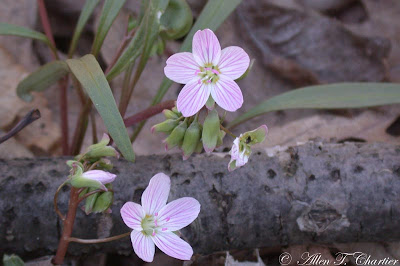
There were lots of other migrants in this small park, including Black-and-white Warbler, Yellow, Yellow-rumped, and Palm Warblers, Blue-gray Gnatcatchers, and Chimney Swifts. The vireo was hanging around with a group of boisterously singing Ruby-crowned Kinglets.
Next it was on to Metro Beach Metropark where a Worm-eating Warbler had been reported. We, along with a number of other birders, spent considerable time looking for this bird without success. I managed a couple photos, including this one of a female Red-winged Blackbird giving an "obstructed view" as discussed a while back on Jochen Roeder's blog. When I repositioned myself for a better angle, she repositioned herself to the other side of the marsh.
When we returned to the Nature Center, we saw this nice Red-headed Woodpecker on the post that they coat with peanut butter to feed the birds.
It had apparently just arrived, as nobody in the Nature Center had seen it yet this spring.
Our final destination, this one for salamanders and wildflowers, was the Highland State Recreation Area. The Ecology Trails in the vicinity of Haven Hill Lake have been one of our favorite local spots for finding salamanders. And we had good luck today too, but not before enjoying some of the wildflowers of the area. There were more Spring Beauties (Claytonia virginica) here than anywhere else I've been this spring.
And many picturesque clumps of Common Blue Violets (Viola sororia) were also in evidence.
One of my favorite violets is the Long-spurred Violet (Viola rostrata), not only for its pale pastel purplish color, but also because it is fairly easy to identify!
We checked a patch of Bloodroot (Sanguinaria canadensis) along the trail where in years past we had found the rare (in Michigan) Twinleaf (Jeffersonia diphylla). It has a flower that is similar to that of the Bloodroot, but the leaves are quite distinctive and give the species its name. We were happy to find one plant, no longer in bloom, as we had failed to find any in our "secret" patch in recent years.
Turning over logs (and returning them carefully), we find a lot of other interesting things. At Oakwoods Metropark on Saturday an Eastern Chipmunk exploded off into the leaf litter when I uncovered his hiding place! Many insects also use rotting logs and loose bark to hide under during the day. Beetles, like this American Carrion Beetle (Silpha americana), are occasionally found.
And we had good success with the salamanders too, considering how dry the woods are this spring. Some years we have found 40-70 Red-backed Salamanders (Plethodon cinereus) on our two-mile "route" at this locale. This year we found seven, four of the all-gray "lead-backed" color morph and three of the "red-backed" morph.

The Red-backed is Michigan's most widespread salamander species. They lay their eggs on the underside of damp logs on the forest floor in August and September, and can be found in virtually any moist woodland with enough "litter" covering the ground during spring. The Blue-spotted Salamander (Ambystoma laterale) lays its eggs in vernal ponds, which dry up by late summer. They retreat to underground burrows after they've laid their eggs so are less frequently encountered as they are above ground for a briefer period each spring. We were happy to find three Blue-spotteds this day, one smallish one (still bigger than the small Red-backs), and two really big ones.

We returned home in late afternoon and spent some time watching our hummingbird feeders, hoping for our first arrival of the spring. But our vigil went unrewarded. Many others have already reported their first hummingbirds earlier than normal this year, but details on that will be covered in the next blog entry in a couple days.





































